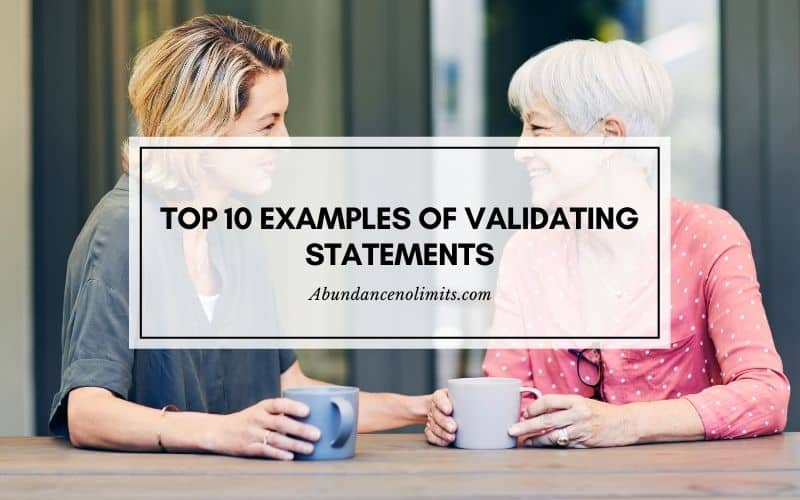How does it make you feel when you are not heard or misconstrued? How do you know that you are heard or understood? How do you recognize that your feelings are accepted by someone else?
That is the role played by validating statements in our conversations. Emotional validation involves understanding and accepting the emotions and feelings of another person. When you listen to the validating statements, you are getting confirmation that your emotions are heard, accepted, acknowledged, and perceived in a way you meant it to.
The absence of such recognizing statements can make you feel that your emotions are being ignored, misread, or misinterpreted. This can make you feel neglected, isolated, judged, and unsupported.
On most occasions, you can take it in your stride and carry on with life. You will say to yourself “Whatever happens, happens” and move forward. After all, it is impossible to control the reactions or behavior of others towards you.
However, you may not be able to write it off like this every time. There are times when you may find it difficult to shake it off. There are times when the apathy and indifference of others will hit you hard. And some people are more sensitive than others about how others react to their emotional needs.
Lack of emotional or communication validation can make you feel unaccepted or rejected. This can lead to mild to severe forms of mental health issues. In some very severe cases, this can trigger psychological disorders like borderline personality disorder (BPD).
What does it mean to validate someone?
Emotional validation means that your emotions are perceived, understood, and acknowledged the way it is intended. It is the process of investing time and effort in learning about the emotions of another person and expressing approval for the same. On the other hand, emotional invalidation involves apparent rejection of another person’s emotional experience.
There is also the in-between path of the neutral approach of no reaction. In this, you are neither acknowledging and accepting the emotions of another person nor are you rejecting them. You choose to ignore them. This is as good as emotional invalidation for the person concerned.
Emotional validation doesn’t imply that you are agreeing with the person’s viewpoint or response. Nor does it mean that you acknowledge that their emotional response or outburst is justified or warranted.
Rather, with emotional validation, you are saying, “I see your emotions and understand what you are feeling and going through”. And, you are making this known to them without shaming or judging them for expressing their emotions. You are also not discouraging them from giving expression to their feelings.
Besides communicating your acceptance of their emotions, emotional validation can help in strengthening relationships by reiterating their importance in your life. It can help the person to become aware of their emotional reactions and work on regulating them.
On the other hand, psychological invalidation can lead to low self-worth and a poor sense of self. They will have trouble controlling their emotions and may even suffer from mental health problems.
Typically, we talk about the emotional validation of another person’s emotions. However, you can also validate your own emotions. Self-validation involves becoming aware of and accepting one’s own feelings and emotions. It is useful to understand yourself better and manage your emotions.
Next, let’s see how to validate someone’s feelings.
How to validate someone’s emotions?
Emotional validation is something that comes to some naturally while others have to learn consciously. Improving this skill can come in handy in building strong relationships. It can also help you self-validate your own thoughts and feelings.
Here are some tips and suggestions for emotional validation.
1. Recognize and acknowledge the emotion
This is the first step in emotional validation. You need to develop the skill to identify the emotions the other person is going through. Often, this is simple enough as emotions are rarely kept hidden. However, some people are good at concealing them or giving confusing signals. This can make it hard for you to know what they want from you.
The best way to deal with this situation is to ask them outright what they are feeling and what they are trying to convey. Sometimes even this can get you into trouble. If the person expects you to read their mind and you ask them what the problem is, sparks may fly. You can guess the emotion they are experiencing and ask them whether you are right.
For example, you went out with your friends for a night out and when you came home late, you found your partner in a foul mood. Even if they are not explicitly saying so, you can sense the anger in them. The ideal thing for you to do is to ask, “I can see that you are angry. Would you like to tell me about it?”.
2. Confirm the cause for the emotion
Asking them openly to tell you about what triggered their emotions may or may not work. Many people don’t understand this themselves, let alone explain it to someone else. If you get a reply, well and good.
If not, you can still acknowledge that something is triggering emotions in them. You can tell that unless they figure it out and tell you, you don’t understand how you can be of help.
If you have a vague sense of the source of the problem, you can ask pointed questions to get them to say it aloud and acknowledge it.
3. Validate the emotion
When you get to know the root cause of the problem, you can either agree with it or just acknowledge the existence of the emotion. It is a tight rope walk and you need to choose your words with care.
In the above example, you can agree with them and accept the blame. If you don’t accept their viewpoint and feel that their anger is not justified as you feel that you are entitled to enjoy a night out with your friends. You may respond, “I understand that you are angry because I left you alone. It was not my intention at all. You know that I asked you to join me but you said you don’t want to come.”
If you feel that you are guilty of offending them, go ahead and apologize. If you do not, you can validate the feeling without apologies. Instead of ignoring, if you validate their feelings, most people are appeased. This can calm them down and you can diffuse the situation.
Common emotional validation examples
- “I’m here for you.”
- “It must be really frustrating.”
- “I can see why you think so.”
- “I would feel the same way.”
- “I hear you.”
- “It seems to me that you are feeling ……”
- “How can I make things better for you?”
- “How long have you been feeling like this?”
- “Would you like to tell me how you are feeling?”
- “Am I getting this right?”
Bottom line
Validation psychology involves acknowledging the emotions, thoughts, and feelings of another person. However, to validate, you need not agree, appease, or change the person or resolve their problems.
Emotional validation can help a person feel heard and understood. This can help avoid needless situations and preventable skirmishes in a relationship. Ultimately, this simple gesture can help you avoid major upheavals in life.


